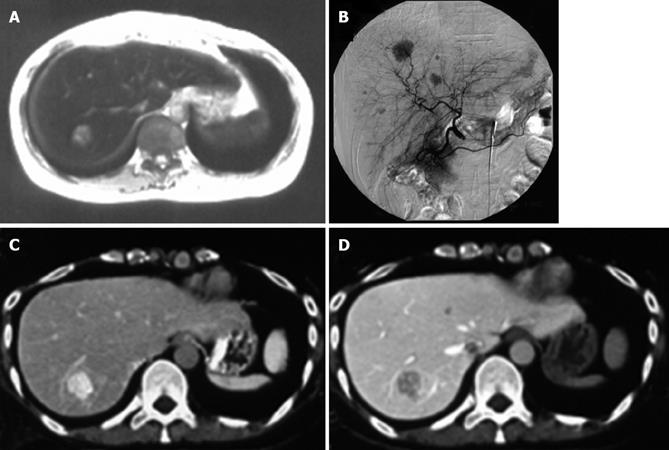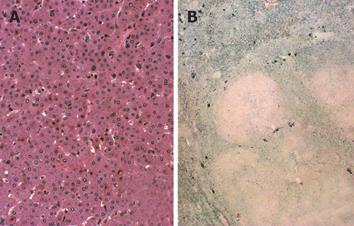Copyright
©2006 Baishideng Publishing Group Co.
World J Gastroenterol. Jan 28, 2006; 12(4): 652-655
Published online Jan 28, 2006. doi: 10.3748/wjg.v12.i4.652
Published online Jan 28, 2006. doi: 10.3748/wjg.v12.i4.652
Figure 1 Radiological features of liver tumor.
A: T1-weighed MRI showing high-intensity masses and reduced liver parenchymal intensities, suggestive of iron deposition in the liver; B: Hepatic arteriogram showing several hypervascular tumors in the liver; C: CTHA showing these mass lesions with increased arterial supply, which reduced portal supply on CTAP (D).
Figure 2 Macroscopic and microscopic examinations of tumor specimen.
A: Macroscopic examination showing well-defined non-encapsulated tumor. Microscopically, the tumor cells are arranged predominantly in a thin trabecular pattern. No portal triad can be seen in the tumor (HE×200); B: The non-neoplastic hepatocytes are almost normal, but contain cytoplasmic hemosiderin (Berlin Blue×20). On the other hand, no iron deposition is seen in the adenoma nodule.
- Citation: Hagiwara S, Takagi H, Kanda D, Sohara N, Kakizaki S, Katakai K, Yoshinaga T, Higuchi T, Nomoto K, Kuwano H, Mori M. Hepatic adenomatosis associated with hormone replacement therapy and hemosiderosis: A case report. World J Gastroenterol 2006; 12(4): 652-655
- URL: https://www.wjgnet.com/1007-9327/full/v12/i4/652.htm
- DOI: https://dx.doi.org/10.3748/wjg.v12.i4.652














